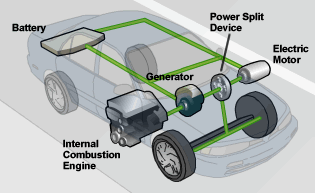Hybrid Vehicles Tutorial
New Hybrid Vehicles Increase Gas-saving Options for ConsumersHybrid-electric vehicles (HEVs) combine the benefits of gasoline engines and electric motors and can be configured to obtain different objectives, such as improved fuel economy, increased power, or additional auxiliary power for electronic devices and power tools.

Some of the advanced technologies typically used by hybrids include
Regenerative Braking. The electric motor applies resistance to the drivetrain causing the wheels to slow down. In return, the energy from the wheels turns the motor, which functions as a generator, converting energy normally wasted during coasting and braking into electricity, which is stored in a battery until needed by the electric motor.
Electric Motor Drive/Assist. The electric motor provides additional power to assist the engine in accelerating, passing, or hill climbing. This allows a smaller, more efficient engine to be used. In some vehicles, the motor alone provides power for low-speed driving conditions where internal combustion engines are least efficient.
Automatic Start/Shutoff. Automatically shuts off the engine when the vehicle comes to a stop and restarts it when the accelerator is pressed. This prevents wasted energy from idling.
More Hybrid Models Avaiable Soon
The number of hybrid vehicles available to consumers continues to grow as Ford Motor Company offers the first commercially available hybrid SUV, the Escape Hybrid, for model year 2005. Toyota Motor Corporation will also be offering hybrid versions of the Toyota Highlander and Lexus RX400 SUVs for model year 2005. Honda will be offering a hybrid version of the Accord for this model year, further increasing consumer choices for hybrid vehicles.
In addition to these new hybrids, the Honda Insight and Civic Hybrid and the Toyota Prius are still available to consumers and offer exceptional gas mileage, the best in their respective classes. These vehicles are also environmentally friendly, emitting less global warming and smog-forming emissions than most conventional vehicles. Hybrid pickup trucks are also available as General Motors Corporation continues to offer the Chevy Silverado and GMC Sierra hybrid pickup trucks to a limited number of fleet and commercial operators in selected areas.
More Hybrids Coming
Soon
How Hybrids Get Great Gas
Mileage
According to automakers, consumers who care about fuel economy will have a dozen hybrid cars and trucks to choose from within the next few years. Below is a list of hybrids and their announced introduction dates.
Manufacturer |
Model |
Type |
Estimated
Date Available |
| Model Year 2005 |
|||
| Dodge | Ram Contractor Special | Fullsize
Pickup |
Fall 2005 |
| Honda | Accord Hybrid | Midsize Car |
Released |
| Lexus | RX 400h | Midsize SUV |
Released |
| Toyota | Highlander | Midsize SUV |
Released |
| Model Year 2006-2008 |
|||
| Saturn | VUE | SUV |
2006 |
| Mercury | Mariner Hybrid | Midsize SUV |
2006 |
| Nissan | Altima Hybrid | Midsize Car |
2006 |
| Chevrolet | Malibu/Equinox | Midsize Car/
SUV |
2007 |
| Chevrolet | Tahoe (AHS II) | SUV |
2007 |
| GMC | Yukon Hybrid (AHS II) | SUV |
2007 |
| Ford | Futura | Midsize Car |
2007 |
| GMC | Sierra Hybrid (AHS II) | Fullsize
Pickup |
2008 |
| Chevrolet | Silverado Hybrid (AHS II) | Fullsize
Pickup |
2008 |
 The links above are to pages that are not
part of the fueleconomy.gov
Web site, or The Auto Channel. We offer these external links for
your convenience
in accessing additional information that may
be useful or interesting
to you.
The links above are to pages that are not
part of the fueleconomy.gov
Web site, or The Auto Channel. We offer these external links for
your convenience
in accessing additional information that may
be useful or interesting
to you.
|
How do hybrids get such great gas mileage?
It is no accident that the most fuel efficient vehicles in some classes for the 2005 model year are hybrid-electric vehicles (HEVs). Hybrids can be configured in many different ways to achieve a variety of different objectives. They combine the best features of the internal combustion engine with an electric motor and can significantly improve fuel economy without sacrificing performance or driving range. HEVs may also be configured to provide electrical power to auxiliary loads such as power tools.
HEVs are primarily propelled by an internal combustion engine, just like conventional vehicles. However, they also convert energy normally wasted during coasting and braking into electricity, which is stored in a battery until needed by the electric motor. The electric motor is used to assist the engine when accelerating or hill climbing and in low-speed driving conditions where internal combustion engines are least efficient. Some HEVs also automatically shut off the engine when the vehicle comes to a stop and restart it when the accelerator is pressed. This prevents wasted energy from idling. Unlike all-electric vehicles, HEVs now being offered do not need to be plugged into an external source of electricity to be recharged; conventional gasoline and regenerative braking provide all the energy the vehicle needs.
Potential buyers should also be aware that the federal government is currently offering tax incentives for HEVs and other alternative fuel vehicles. Some states also offer incentives.
For fuel economy information on these vehicles, please visit the Compare Side-by-Side section.








